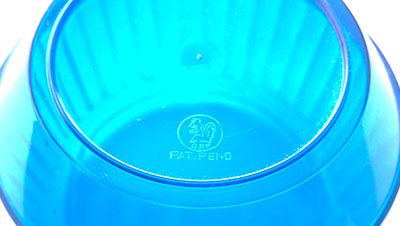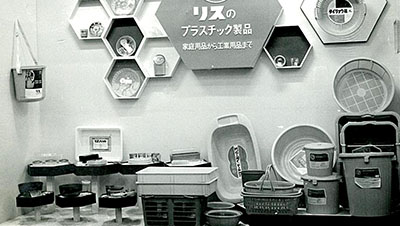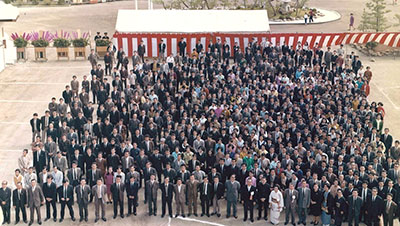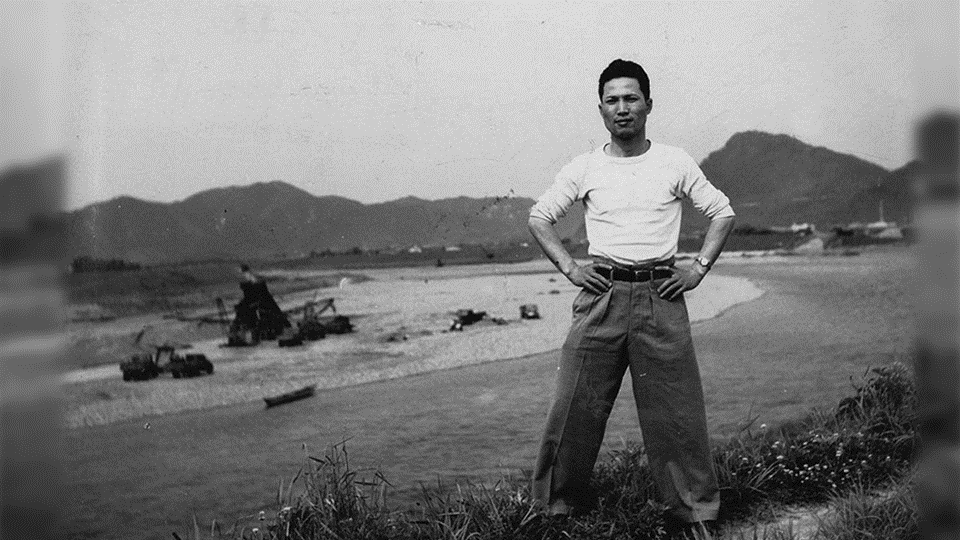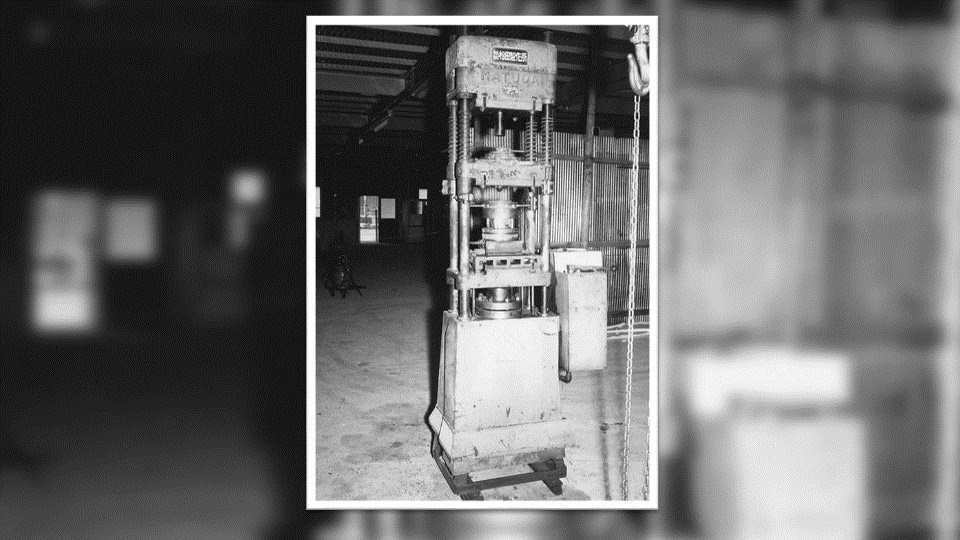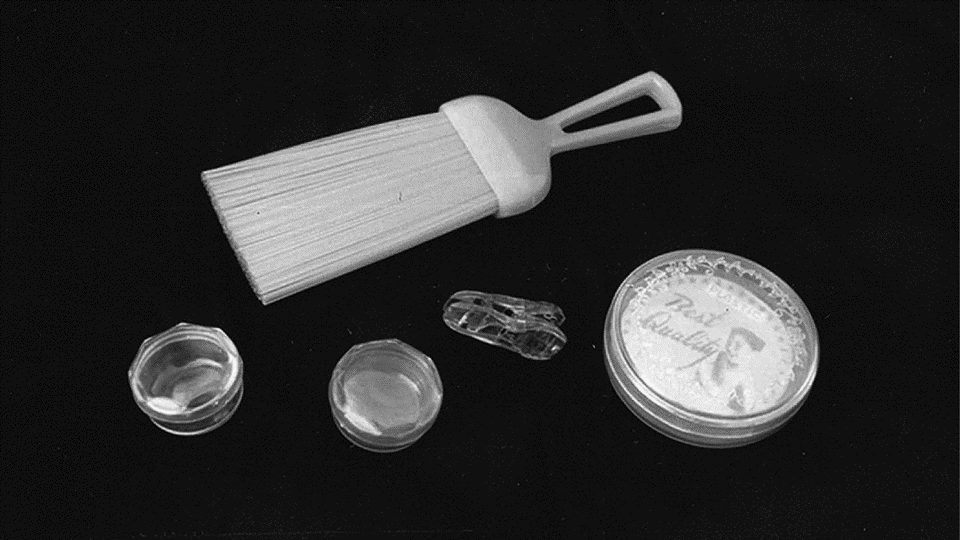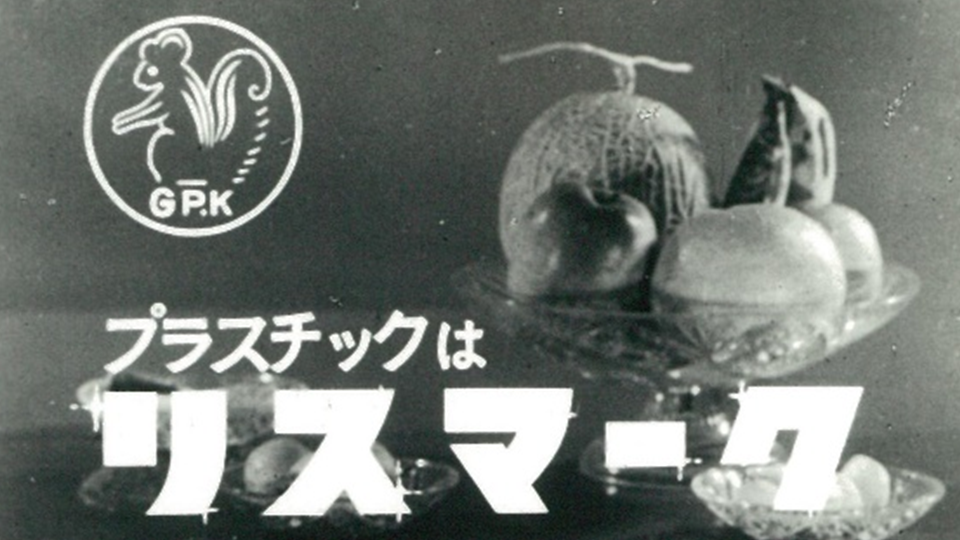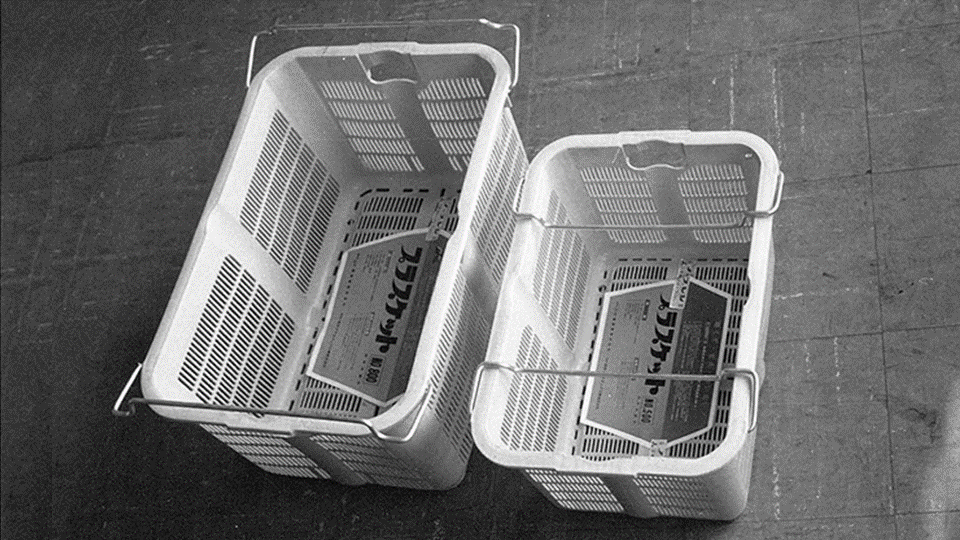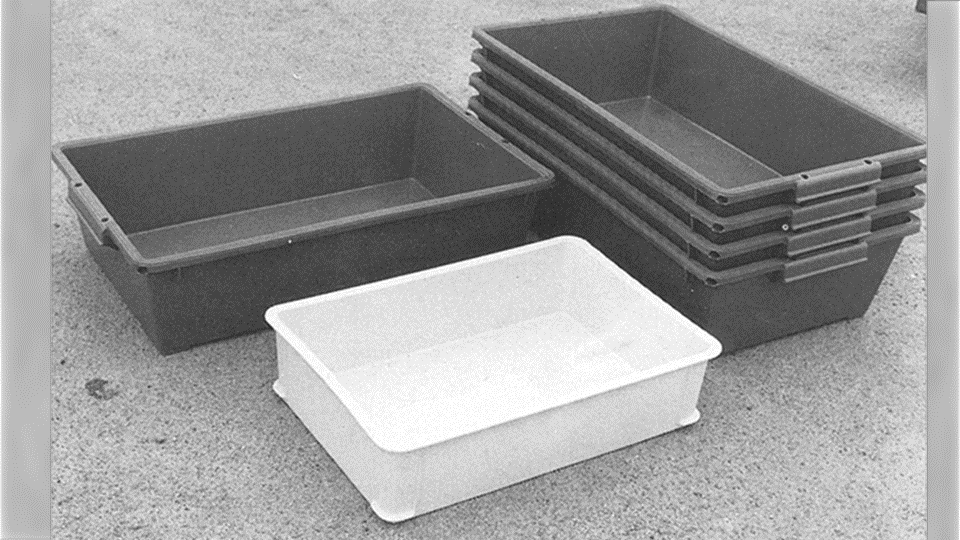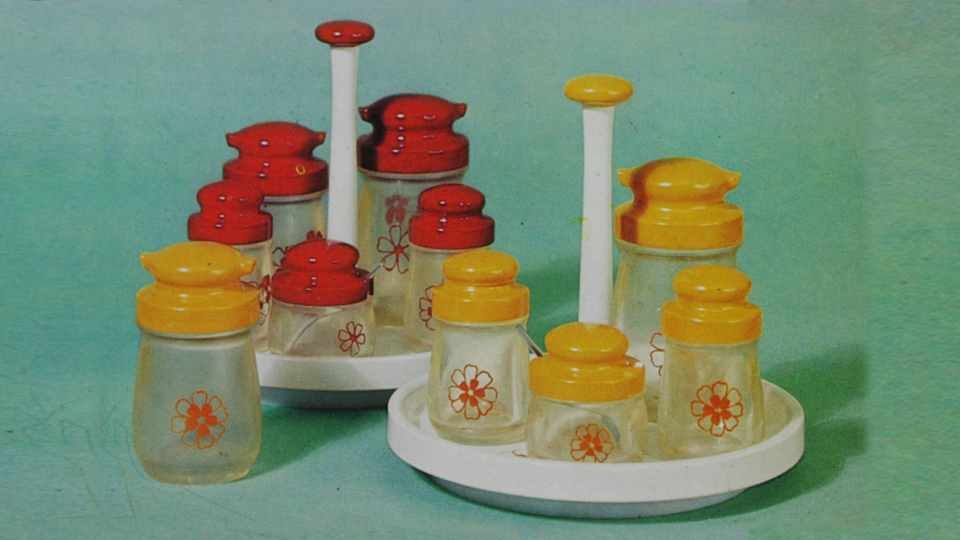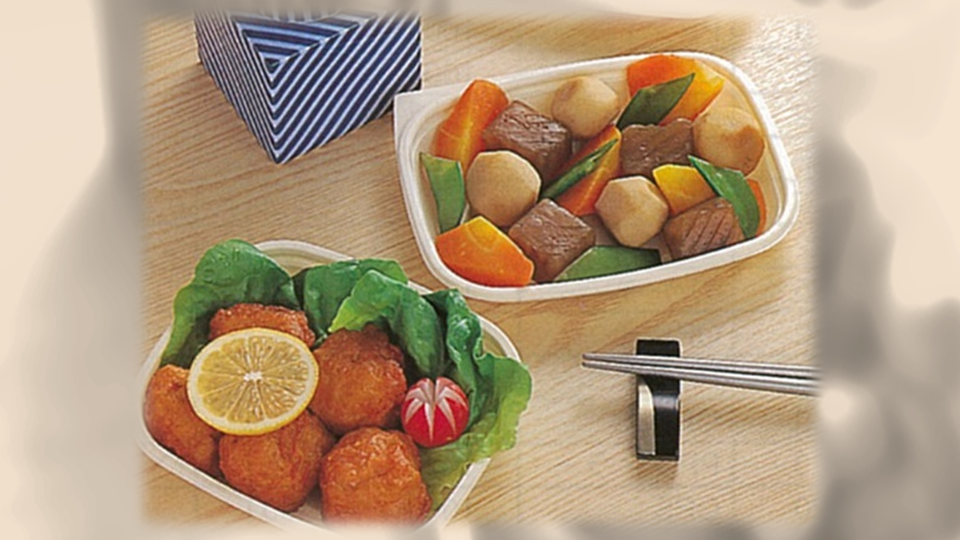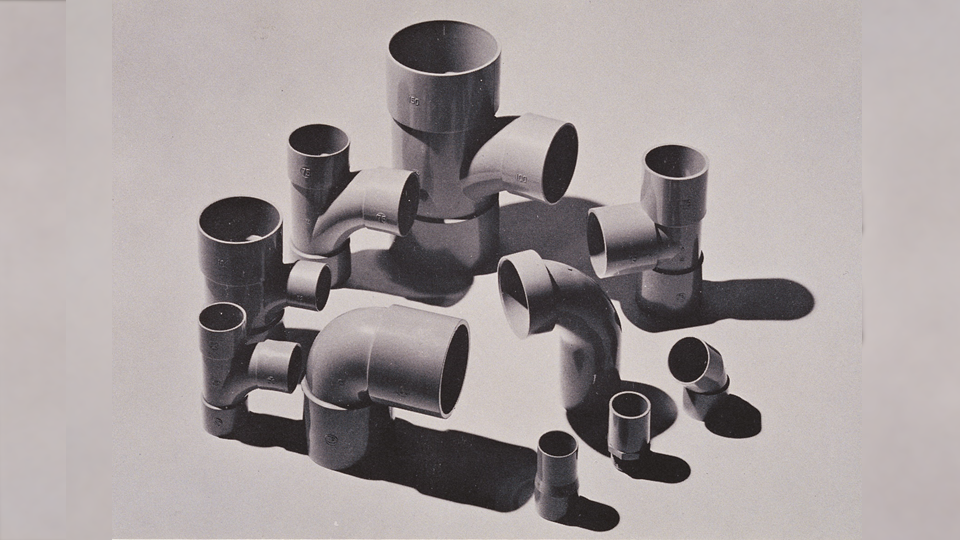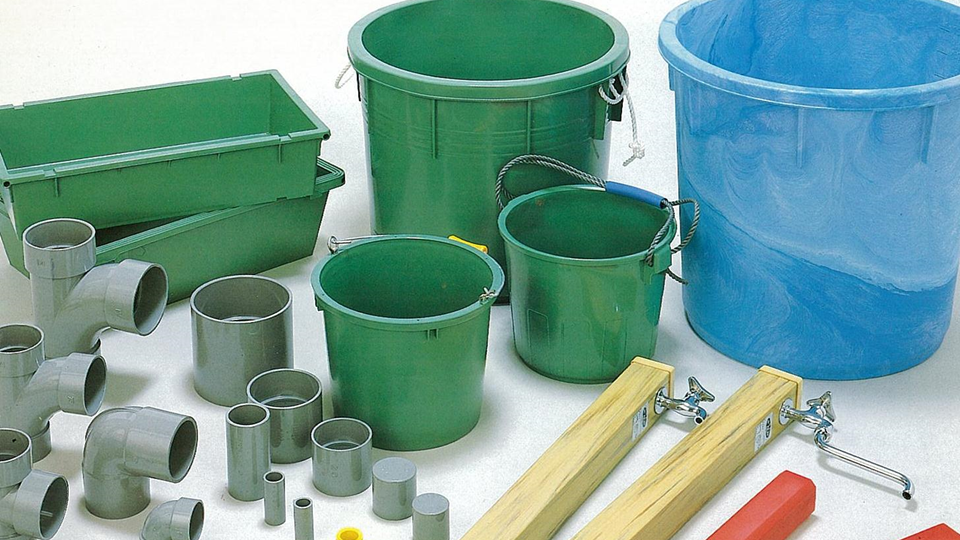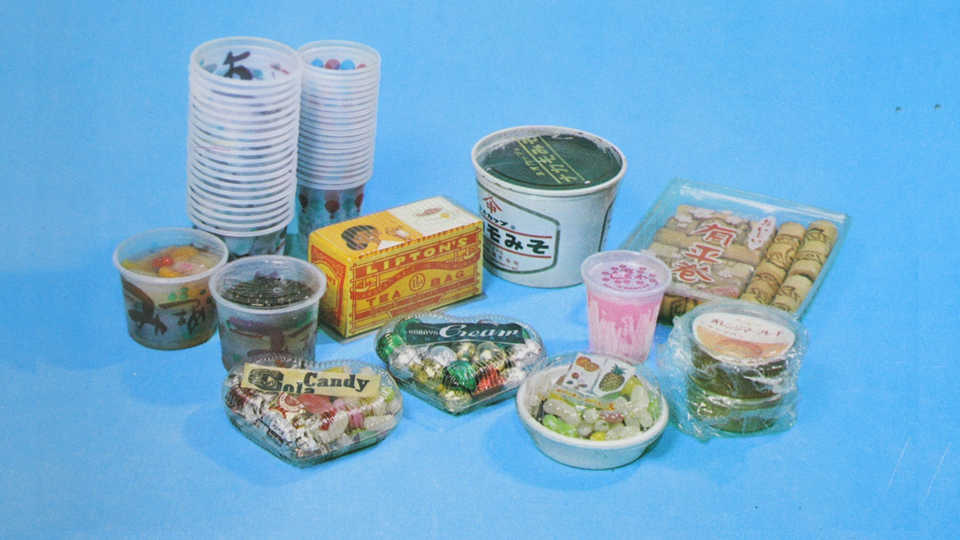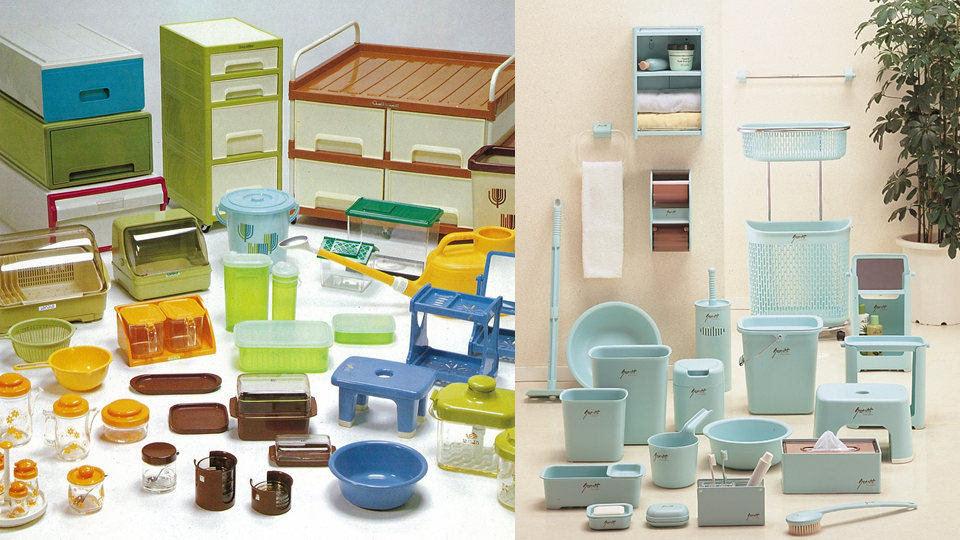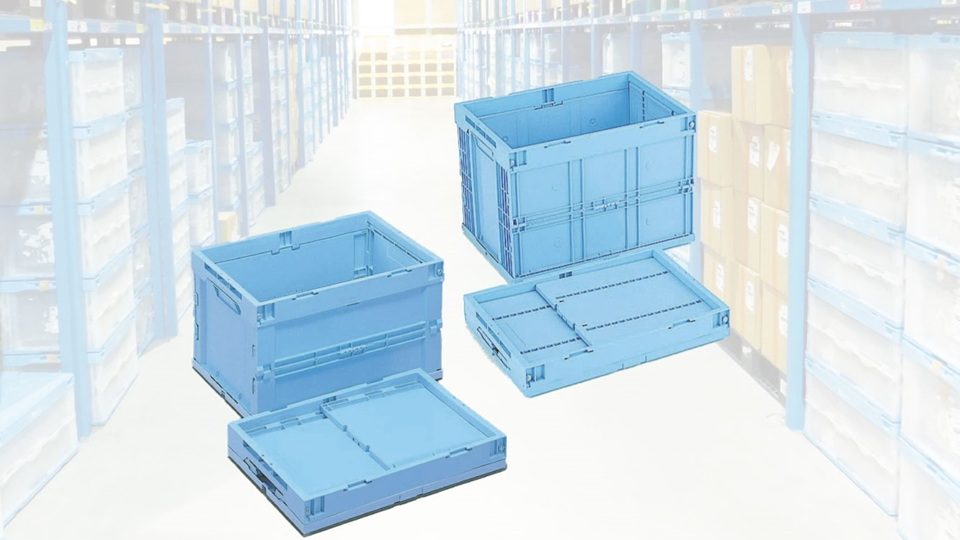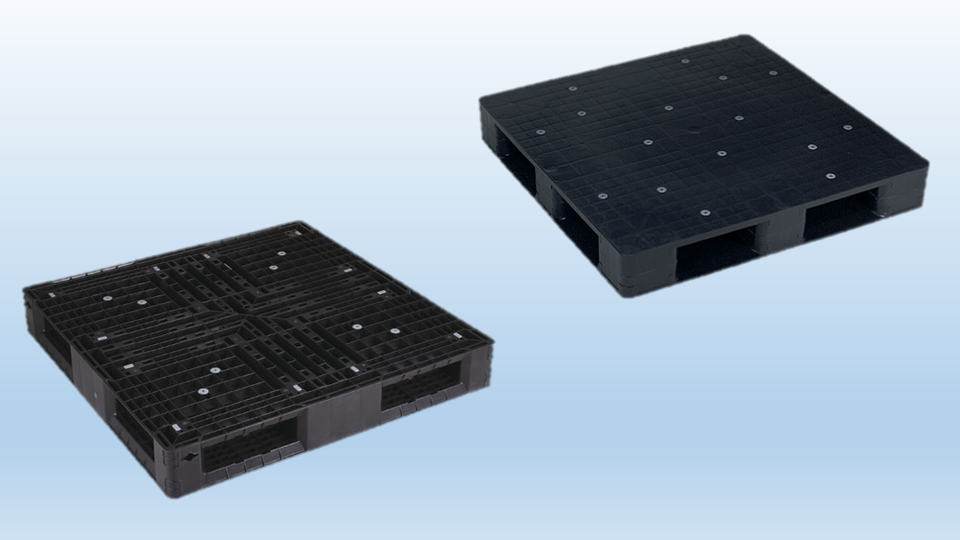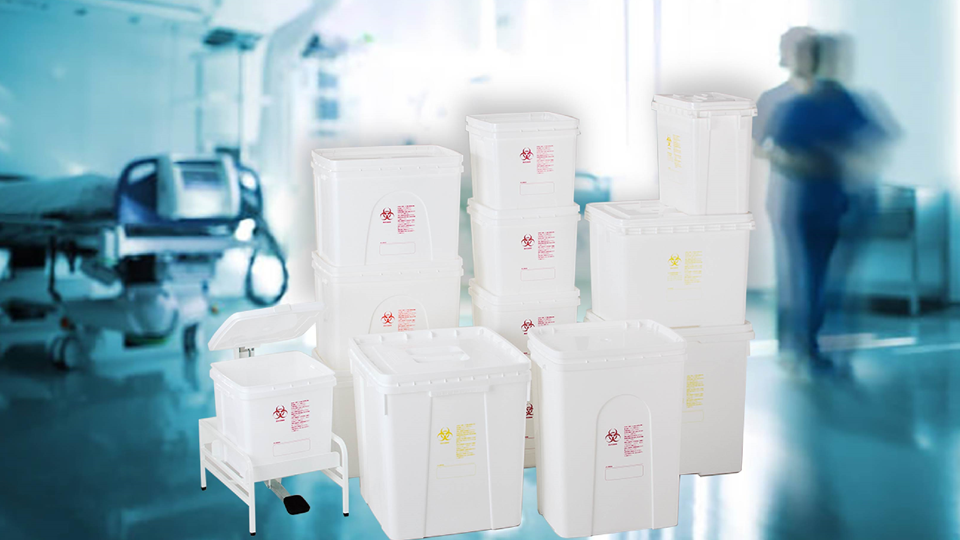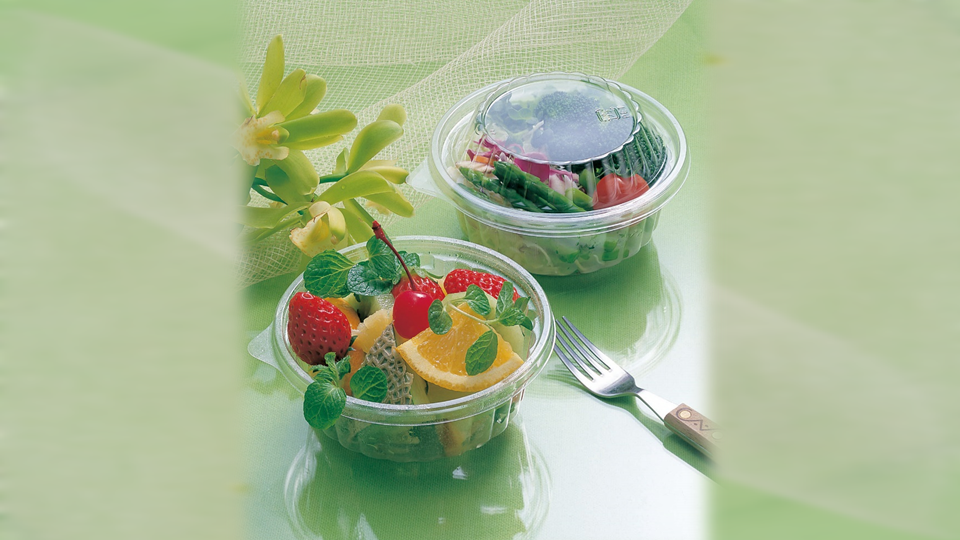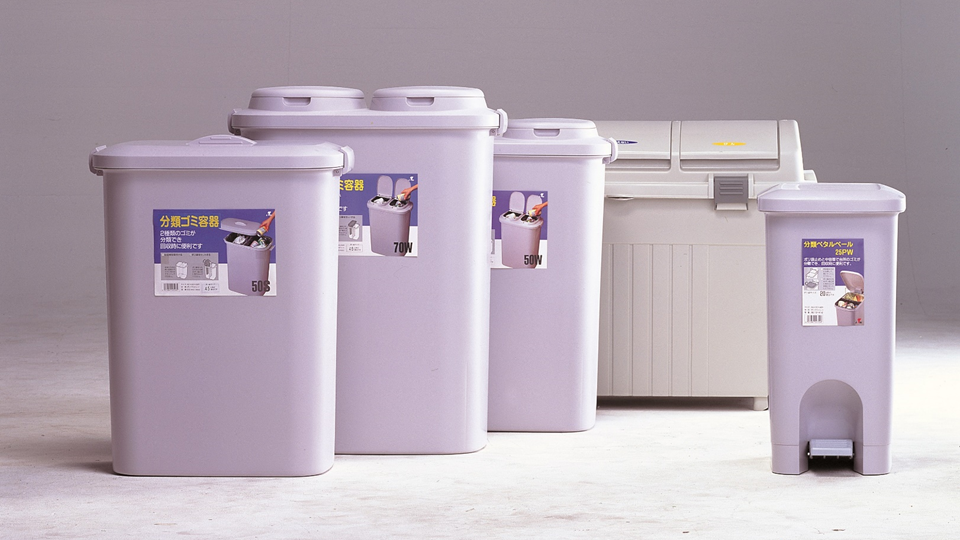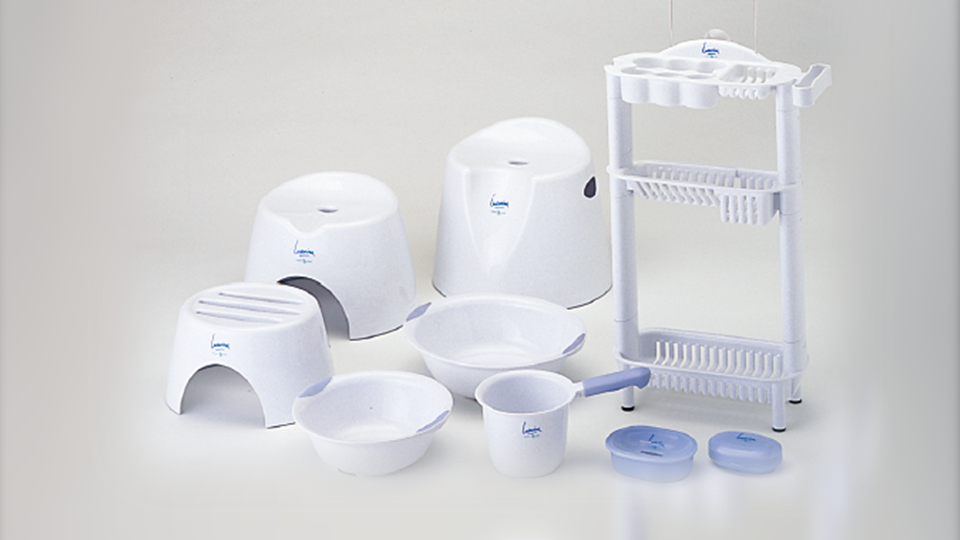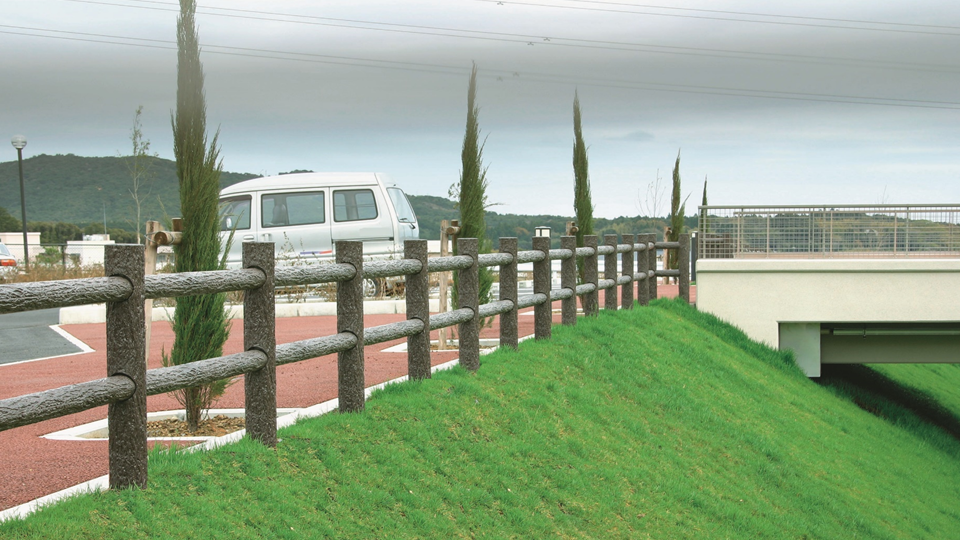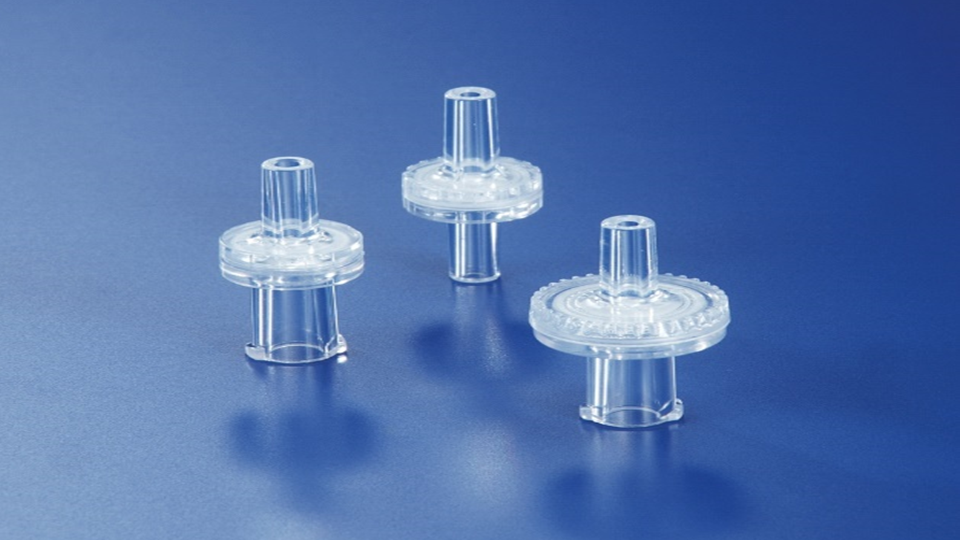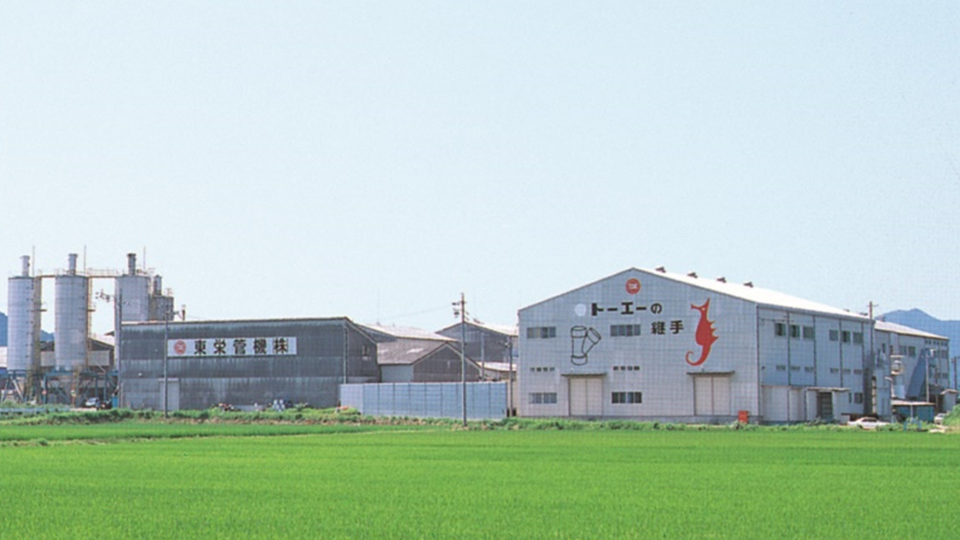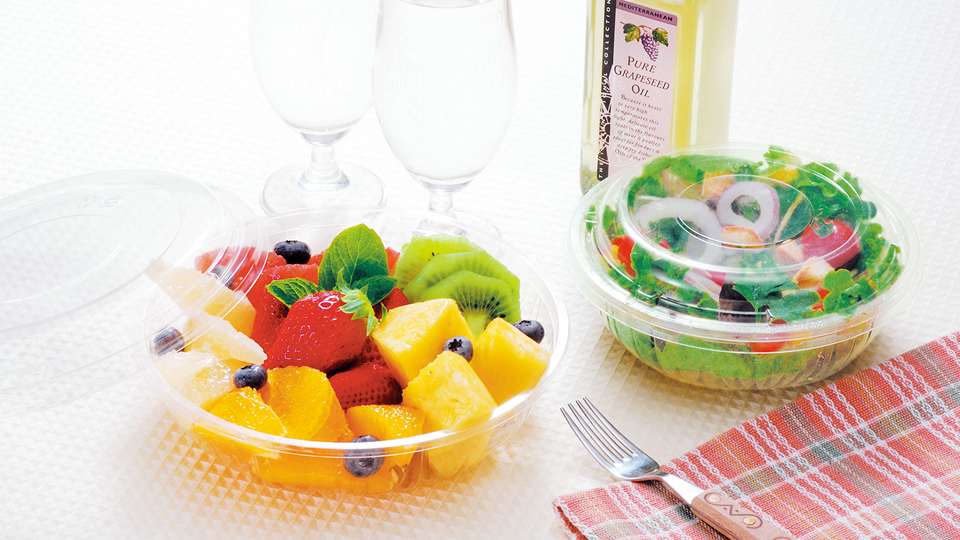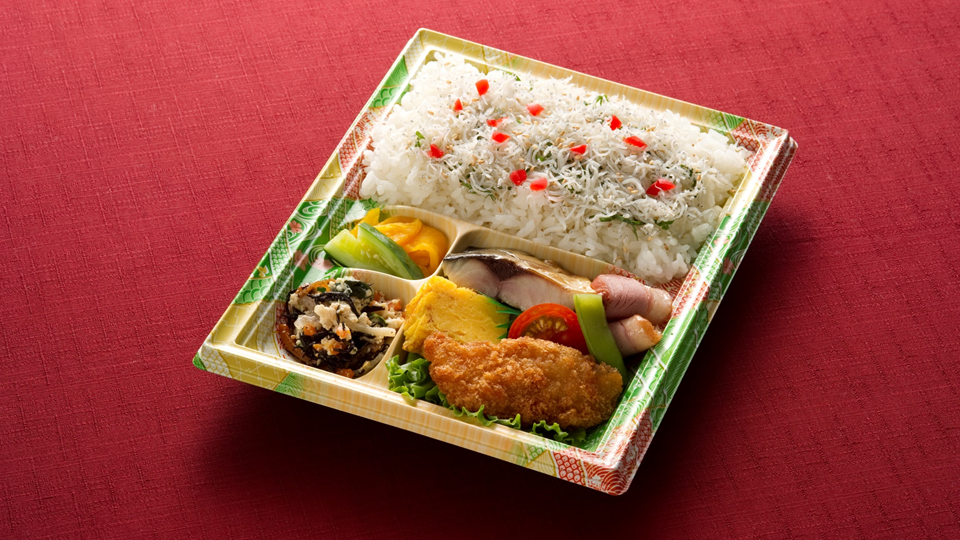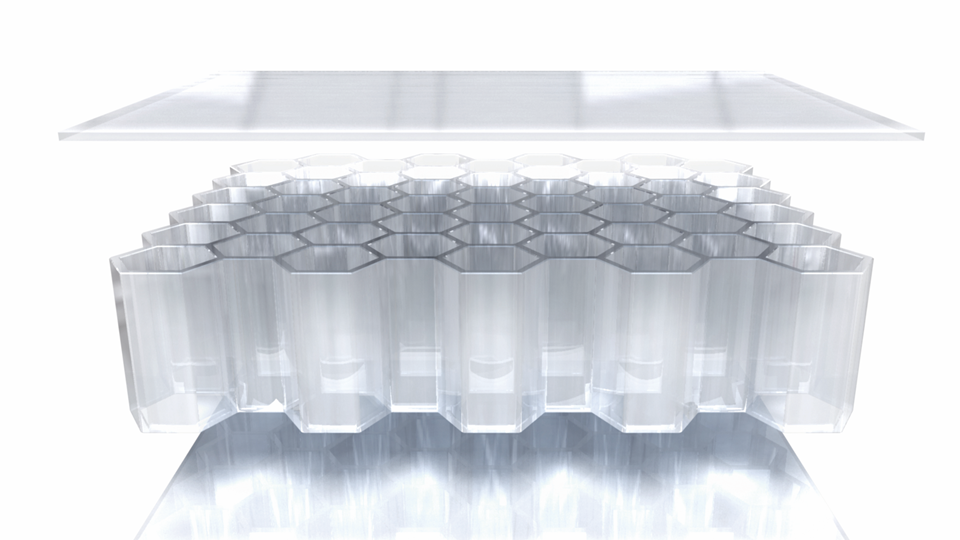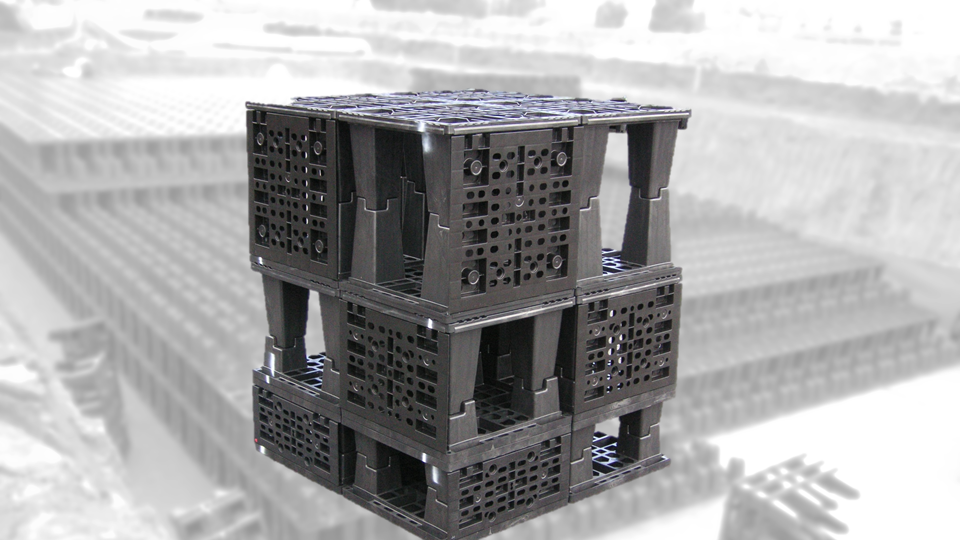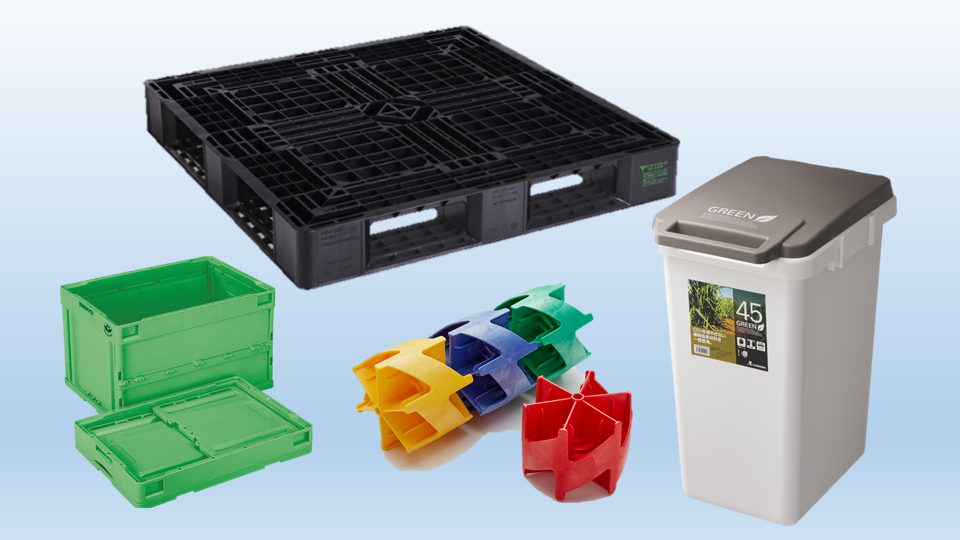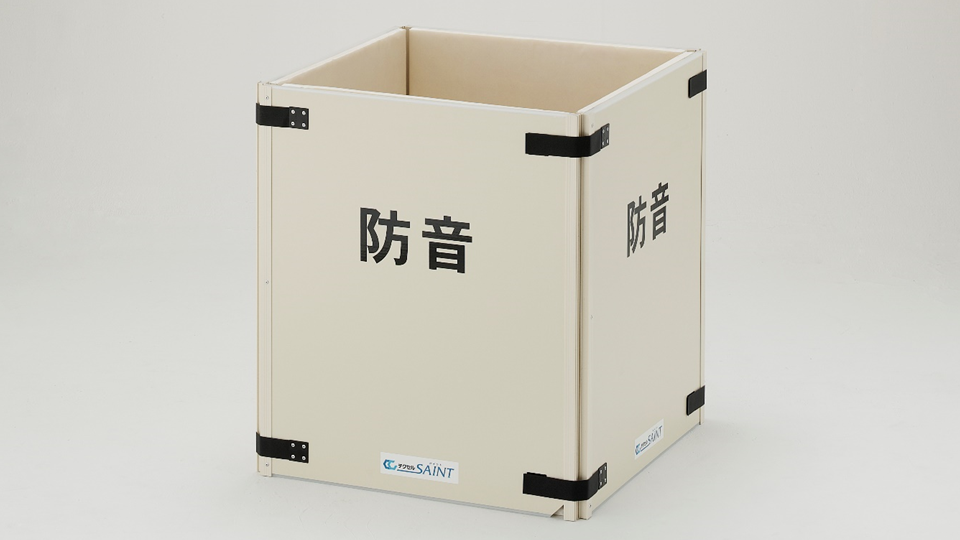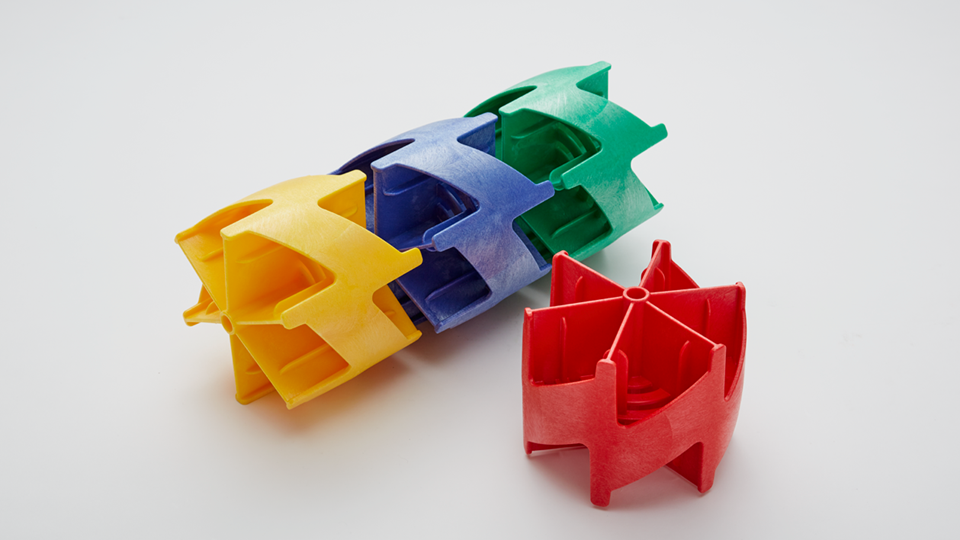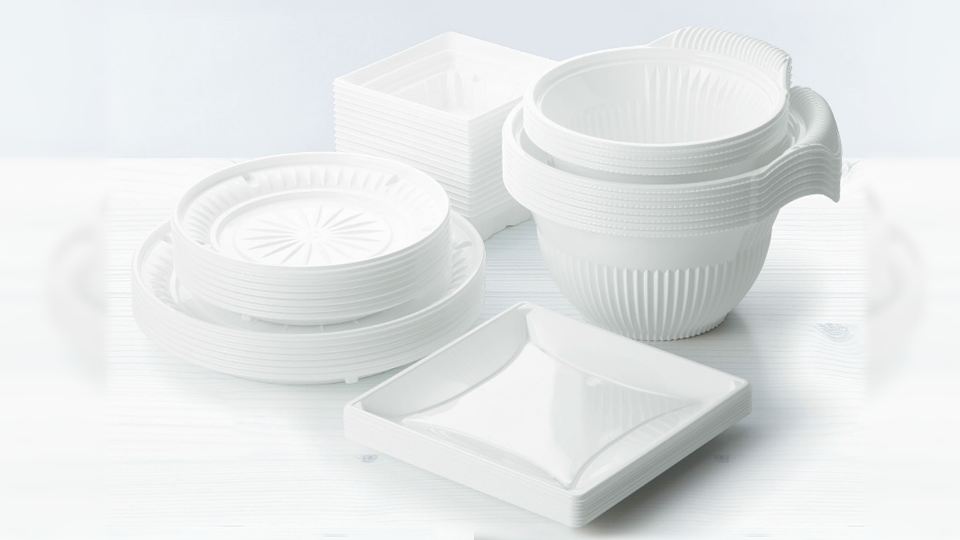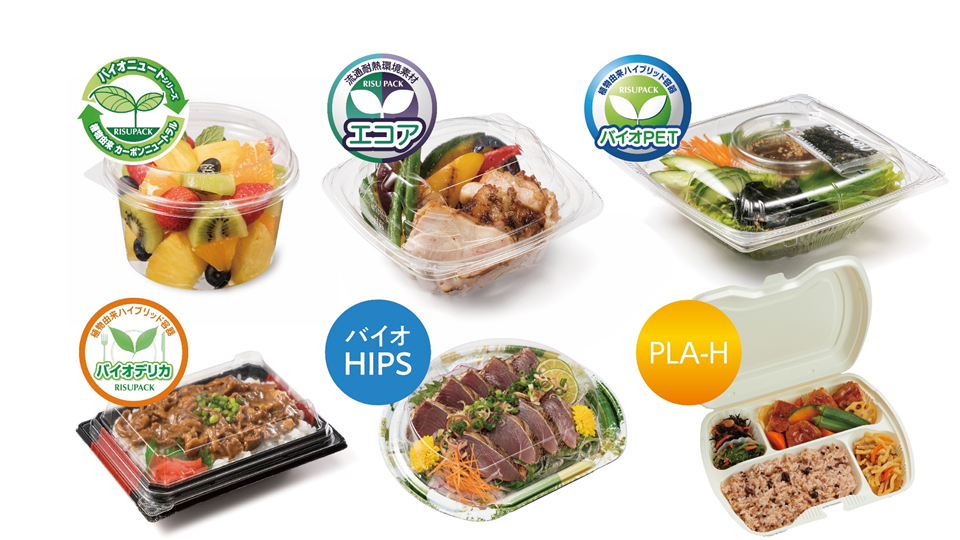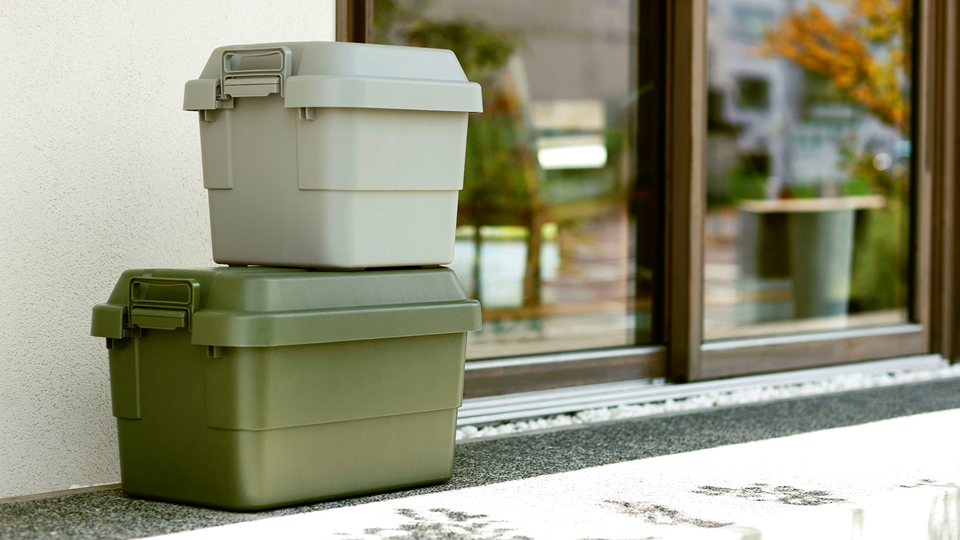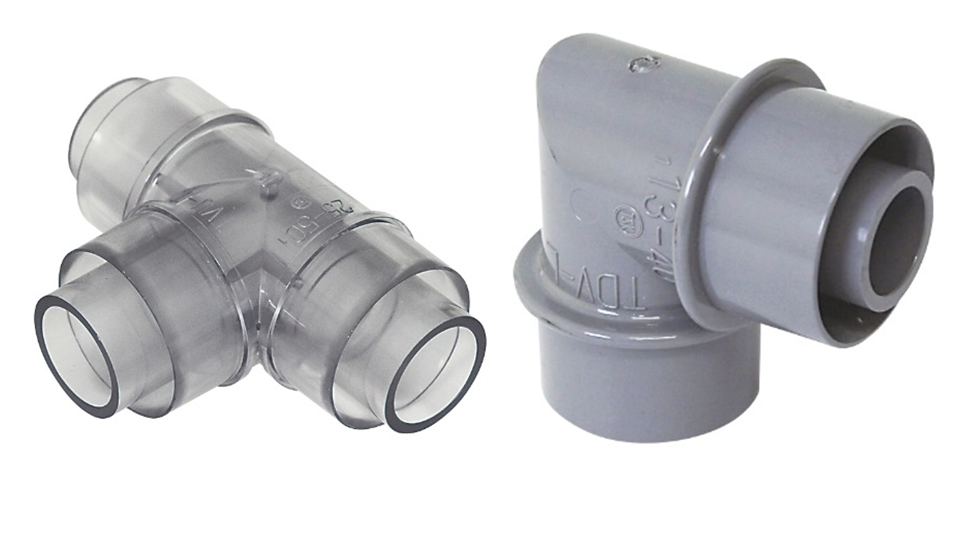Establishment in 1953
"Encounting New Materials"
April 1953, shortly after the end of World WarⅡ, Gifu Plastic Industry was established in Gifu City, which still bore the scars of air raids.
The founder of Gifu Plastic Industry was a young man named Koei Omatsu, who was 28 years old at the time.
Establishment in 1953
Founder, Koei Omatsu
The founder of Gifu Plastic Industry, Koei Omatsu, in the tumultuous post-war era of Japan, recognized the potential of a relatively unknown material called a plastic.
Witnessing the beginning of a material revolution taking place overseas, he became convinced that it was a technology that would thrive in the future. With this conviction, he made the bold decision to leave his position at a textile company and venture into the field of plastic manufacturing.
This marked the first step pf the "CHALLENGE" that resonates within Gifu Plastic Industry.
Establishment in 1953
The first injection molding machine installed in the company
In the midst of starting a business from scratch, with virtually no capital, no credit, and no connections, the first plastic molding machine purchased was a Japanese-made prototype.
It cost approximately 1 million yen at the time, which would be equivalent to around 6 million yen in today's currency. Although there were more expensive machines modeled after foreign-made ones, the limited financial resources at the time made this the best option.
※6million yen = US$38,700 in present rate (as of Jun2024)
This first vertical molding machine, introduced in June 1953, symbolizes the Group's history of taking on challenges. It is still on display in the office in the main factory in Kakamigahara City, Gifu.
Establishment in 1953
First Shipment : Compact Case
Soon after the company was founded, it began manufacturing products such as frozen containers for ice cream and bobbins for thread spools, but none of these efforts yielded any significant results. In September 1953, while riding around Osaka City on his bicycle looking for work, he received an order from Kansai Plastic Trading Company for a round compact case to hold cosmetics.
He worked on the mold designs through the night and made many round trips between Gifu and Osaka with the prototypes. Finally, at the end of November of the same year, the first batch of 500 units was completed. Since plastic was a rare material, they were sold not in the cosmetics section but in a display case in the jewelry section.
Establishment in 1953
Brand Logo Inspired by Squirrel
In 1957, we established a trademark to identify our products and enhance their image. Several animals were considered, but the squirrel was chosen in hopes that our products would be as adored as they were, as well as its hardworking habit of storing food for the winter during the summer. At that time, our logo featured a depiction of a squirrel, and when our sales representatives visited customers, the products were often referred to as “RISU's Plastic," solidifying the brand recognition.
In 1989, as we celebrated our 35th anniversary, we revamped our brand logo. The main color became red, and the bold line extending upwards in the shape of the letter "R" symbolized freedom and creativity, while the white "R" within represented the expansion of the group. It boldly portrayed the image of "RISU" continuously leaping toward the future.
Products that Represent the Era
Year of 1953-1990
Aligned with the rapid economic growth of the post-war period, the plastics industry experienced a prosperous era. Along with it, Gifu Plastic Industry created various hit products and expanded into various new fields, such as food packaging containers, PVC pipe fittings, and containers, culminating in the products that shaped the era.
Products that Represent the Era
Plasket
In the fishing and agriculture industries, a product that has become a staple is the "Plasket," which was introduced in 1964. The initial model, designated as No. 800, continues to be produced today with the same specifications, making it a long-lasting product. The product name, which combines "plastic" and "basket," is still commonly used as a nickname.
Furthermore, at that time, a demonstration was conducted where the Plasket was pulled by a 4-ton truck, showcasing its durability and resilience as a promotional effort. This demonstration highlighted the exceptional quality of the product at the time.
Products that Represent the Era
Plastic Tub
In traditional plastering work, there's a tool used for mixing mortar or cement and wall materials known as a "PLA-FUNE" = Plastic Tub. Conventionally, tubs were made of iron or wood. In 1966, the sale of a plastic tub called the "PLA-FUNE" was introduced. Iron tubs tended to rust and the plastic tubs gradually began to replace them. During the era of rapid economic growth in Japan, there was an increase in housing construction, which allowed the sales of the plastic tub to grow exponentially.
The distinctive green color of our "PLA-FUNE" is derived from the fact that the original iron tubs were green in color. This choice was made in hopes that plasterers would smoothly transfer to using the plastic tubs. Today, the color green has become synonymous with our plastic tubs, firmly establishing its presence on construction sites.
Products that Represent the Era
Très Bien
In 1972, the "Très Bien" was introduced as a high-end tabletop condiment set. Its rounded form, the use of acrylic resin for a transparent and luxurious appearance, and the substantial design aimed at creating a sense of high quality made it the best-selling series of condiment sets, both in terms of longevity and quantity.
During that time, whenever a dining scene appeared in television dramas, the presence of “Très Bien” was a common sight, solidifying its status as a product that truly defined the era. Furthermore, its successor model, "BLOOM," featuring a cherry blossom motif, had its unique design registered as a three-dimensional trademark in 2020.
Products that Represent the Era
High Cooker
The High Cooker, introduced in 1987, was a heat-resistant container capable of with standing temperatures up to 275℉. If gained significant sales as a container for take-out meals from convenience stores.
During the 1980's, with the rise of convenience store as a new retail format and the widespread adoption of microwave ovens in households, there was a demand for the development of new food packaging containers that could be heated in microwaves. The High Cooker was created to meet this demand.
It quickly gained market share, competing amongst the top of the convenience store sector. Furthermore, efforts were made in product development to cater to supermarkets, such as designing the shape of the bottom to enhance visibility of the efforts in product development led to the product being recognized and praised as the Heat-Resistant RISUPACK.
Products that Represent the Era
PVC Pipe Fittings
As the competition for market share in the household goods sector intensified in the 1960s, Gifu Plastic Industry identified rigid polyvinyl chloride (PVC) pipes as a stable new business opportunity. However, the production of PVC pipes required large extrusion machines, so the company decided to specialize in manufacturing PVC pipe fittings, which connect the PVC pipes.
Recognizing that it would be inefficient for each pipe manufacturer to have over a hundred different types of fittings, Gifu Plastic Industry proposed the centralized production of fittings for major pipe manufacturers. In 1963, after entering into production contracts with pipe manufacturers, the company commenced full-scale production and sales.
As a result, Gifu Plastic Industry developed and produced a variety of fittings for PVC pipes used in water supply, drainage, and sewage systems, among other applications. These fittings became a significant part of the company's history within the group.
Year of 1971-1988
Divisionalization
Expansion of our products in each field has progressed, and through specialized operations and meticulous sales efforts in each industry, we have successfully expand our business.
Year of 1971-1988
RISU KOGYO Co., Ltd.
In April 1971, as the first subsidiary of Gifu Plastic Industry, Risu Kogyo Co.,ltd. was established. It started as a sales division focusing on the civil engineering and construction industries, dealing with PVC pipe fittings, various building materials, and civil engineering supplies.
After the establishment of Risu Kogyo, the development of PVC pipe fittings expanded to include water supply fittings, drainage fittings, thin-walled drainage pipes, sewage pipes, and other types of fittings and sewage basins for various applications. This led to closer customer-oriented sales and product development efforts.
Year of 1971-1988
RISUPACK Co., Ltd.
In 1975, in order to enhance specialization in food packaging containers, Risupack Co.,ltd. was established as the second subsidiary.
An integrated organization combining "production" and "sales" was created to adapt to demand trends that were greatly influenced by price competition and weather conditions.
Furthermore, a high-performance large-scale sheet extrusion molding machine was introduced, enabling in-house sheet production. This allowed for stable quality and cost reduction. The introduction of this first machine laid the foundation for an integrated production system from sheet production to molding.
Year of 1971-1988
RISU Co., Ltd.
In 1985, Risu Co., Ltd. was established as a separate entity for the sales and planning departments of household goods. To meet the diverse needs of consumers, the company established a system to plan and develop unique products of higher value from both long-term and short-term perspectives.
Additionally, Risu's joint development department was responsible for co-developing products with MUJI, contributing to the expansion of MUJI's sales by providing unified support from design to production. Subsequently, in 2005, Risu Joint Products Co., Ltd. was established to enhance the planning capabilities of the joint development department.
Year of 1989-2002
Environmental changes
We have responded promptly and accurately to major environmental changes such as the economic bubble, subsequent recession, rapid IT advancement, and globalization.
We have also been quick to initiate product development that incorporates recycled materials and universal designs, resulting in significant achievements across a wide range of industries.
Year of 1989-2002
Foldable Containers
The use of industrial containers began with primary industry sectors such as fisheries and agriculture and later expanded to secondary industries such as automotive and machinery manufacturing. In addition to large containers for automotive parts, containers with conductivity and stackability, as well as reusable two-colored containers and foldable containers for transitioning away from corrugated cardboard, were developed.
These products, which continue to be utilized across various industries today, were designed to maximize transportation efficiency. In particular, the "foldable containers" were revolutionary at the time, as they could be easily assembled by anyone and reduced to one-fourth of their size when folded. They fulfilled the demand for streamlined distribution and played a significant role in rationalizing work processes.
Year of 1989-2002
Pallet Market & Recycling Technology
In fields where wooden pallets were traditionally dominant, there has been a shift towards plastic pallets due to their durability, hygiene, and mechanical characteristics. In 1990, Gifu Plastic Industry introduced large-scale injection molding machines and started production.
Furthermore, in 1993, the company successfully developed pallets made from 100% recycled materials, laying the foundation for the expansion of recycling pallets and popularizing black-colored pallets in the industry.
Year of 1989-2002
Medical Pails
In response to the requirement of placing infectious medical waste, such as gauze, bandages, needles, and surgical gowns, in sealed containers for collection and incineration, Gifu Plastic Industry developed highly sealed medical pails and released them in 1990.
Illegal dumping of medical waste has been a significant social issue, leading to stricter regulations and penalties by national and local governments. As a result, the demand for medical pails rapidly increased.
In the present day, Gifu Plastic Industry has developed containers with enhanced heat resistance by mixing polycarbonate material with polypropylene, which was traditionally used for incineration purposes. These containers can be repeatedly used after sterilization, contributing to a container-based infectious waste disposal system.
Year of 1989-2002
Food Packaging Containers for Environmental Issues
In 1985, a research paper was published indicating that Freon gases, a commonly used gas as refrigerants in refrigerators and coolers, posed a threat to the ozone layer. In response to this, in 1989, Gifu Plastic Industry made a significant switch from using Freon gases to using butane gas as a foaming agent in sheet molding.
Furthermore, the industry had traditionally relied on polyvinyl chloride (PVC) as the main material for transparent cup containers. However, due to growing concerns about the environmental impact of PVC, Gifu Plastic Industry took proactive measures and quickly transitioned to using A-PET (Amorphous Polyethylene Terephthalate) resin, which is a safer and more environmentally friendly material. A-PET resin has low calorific value when incinerated, and its carbon dioxide emissions are comparable to those of paper.
It is considered a material with excellent environmental suitability. The transition to A-PET resin involved overcoming various challenges, but through continuous improvements in technology, molding machines, and materials, Gifu Plastic Industry successfully introduced A-PET resin containers to the market. Today, our transparent containers under the brand name "RISUPACK" lead the industry in terms of environmental friendliness.
The switch to butane gas and A-PET resin demonstrates our commitment to addressing environmental concerns and striving for sustainable solutions in our product development. We continue to explore innovative materials and technologies to reduce environmental impact and provide customers with safe and eco-friendly packaging options.
Year of 1989-2002
Development of Recycling-Friendly Dust Bins
In the 1990s, as the issue of waste management became more serious, and with the increasing awareness of recycling, waste segregation programs were implemented by local governments. At RISU Corporation, we responded to this trend by introducing a horizontally divided waste container in 1993, which allowed for easy sorting of waste. This marked the beginning of our development of kitchen-friendly sorting pails known as "Pedal Pale."
Since then, we have continued to expand our product line up to meet the needs of different installation spaces, including three-compartment containers, horizontal and vertical designs for space-saving purposes. These products have become popular items in various home improvements stores.
At RISU, we strive to offer a wide range of waste containers that adapt to changing lifestyles.
Year of 1989-2002
Universal Design in Daily Products
We have been advancing the development of everyday products that incorporate the concept Universal Design, which aims to create designs that are easy to use for people of all ages and abilities.
In 1999, we introduced bathing product called "Lasrevinu," which was named by using the word "Universal" spelled backward. We reevaluated product sizes and capacities, focusing on reducing strain on the lower back when sitting, ensuring ease of body washing, and designing a bath bucket that is easy to scoop hot water with.
Since the 2000s, Universal Design has become a core concept in our product development at RISU Corporation, resulting in the creation of numerous user-friendly products for a wide range of people.
Year of 1989-2002
Construction Materials
In 1992, Risu Kogyo Corporation developed plastic simulated wood products as a means to promote contributing to the environment and the recycling of plastic waste. Using 100% recycled materials, the company created a stable and cost-effective product that was recognized in the market as an environmentally friendly solution. This was named "PLAWOOD."
Building on its unique molding technology, Risu Kogyo Corporation expanded its product line to include items such as simplified steps and planters in similar fields. As a leading manufacturer of plastic simulated wood, these products have gained recognition and are widely adopted in public projects, including parks, walking paths, disaster evacuation routes, and retaining walls, primarily in government and municipal construction projects.
The PLAWOOD series, along with other related products, continues to be utilized in various applications, contributing to sustainable and eco friendly development.
Year of 2003-2012
Contemplating the future
Recognizing the increasing focus on global environmental issues, we quickly embarked on the development of environmentally friendly products and ventured into new business areas to adapt to the changing social needs.
Other Topics
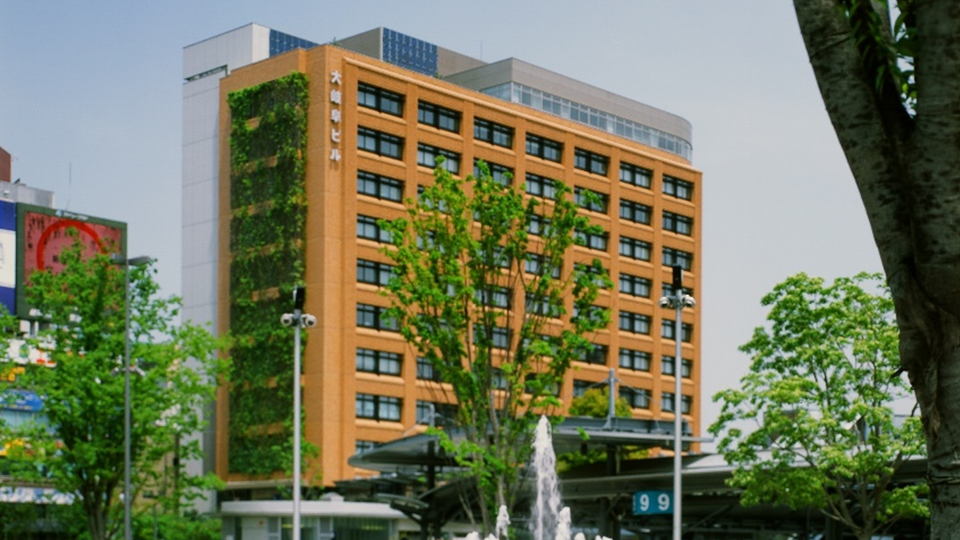
■ Contribution to the Revitalization of Gifu Station Area ■
In 2005, the headquarters of the Gifu Plastic Group, known as the “Dai Gifu-Building," was completed in front of JR Gifu Station, the main entrance to Gifu City. It was the first project of urban redevelopment that involved the surrounding area. A garden was installed on the roof of the building, and greenery was planted on the west wall, creating a soothing landscape while mitigating temperature rise on the wall.
In recognition of these efforts, the company received the Minister of the Environment's Award in a competition sponsored by the Urban Greenery Technology Development Organization.
Year of 2003-2012
Start Entering the Medical Field
In order to make a full-fledged entry into the medical field, we started selling air filters for hemodialysis blood circuits in 2005.
In 2009, we also succeeded in receiving orders for caps for medical devices used in dialysis from a major medical equipment devices.
Year of 2003-2012
Acquisition of TOEI KANKI Co., Ltd.
In 2011, we acquired the shares of Toei Kanki Co., Ltd. and established it as a subsidiary.
Toei Kanki is a specialized manufacturer of fittings for PVC pipes located in Seki City, Gifu Prefecture, and was also a customer of our subsidiary, Risu Kogyo's fitting sales division.
While Risu Kogyo focused on contract manufacturing for pipe manufacturers, Toei Kanki had its own branded products stocked at its 12 branches and sales offices nationwide, with a strong emphasis on prompt delivery and attentive customer service. With its production facility's close location, minimal competition in the sales market, and sound management practices, the discussions progressed smoothly.
After the subsidiary was established, we transferred the fitting sales division of Risu Kogyo to Toei Kanki, resulting in synergistic effects, significantly increased sales volume, and the revitalization of the fitting business.
Year of 2003-2012
Bioplastic Food Packaging Container
Bioplastics, derived from plants, are environmentally friendly plastics that use plant-based raw materials, do not contribute to increased CO2 levels in the atmosphere, and help conserve valuable petroleum resources.
In the 1990s, plant-based resins gained attention as materials that contribute to environmental protection. In March 2003, Risupack conducted test sales of food packaging containers made from polylactic acid resin, which is derived from plants, making it the first company in Japan to do so.
In 2005, Risu Pack's container received certification as the first polylactic acid vacuum-formed product from the Association of Polyolefin Hygienic Products.
The containers were also adopted as official containers for the Expo 2005 Aichi Japan, further establishing Risupack's production and sale of bioplastic food packaging containers.
This milestone led to the introduction of bioplastic products in other fields within the group.
Year of 2003-2012
Environmentally Friendly Containers
Declaration of Safety, Security, and Sustainability in Food Packaging
As consumer demands for safety and quality have increased, Risu Pack has adopted the policy that "containers are also part of the food." In line with this philosophy, Risu Pack has announced the "Declaration of Safety, Security, and Sustainability," which consists of the following three principles:
⓵ Use of Materials Proven to be Safe and Secure
⓶ Implementation of Safe and Secure Production Systems
⓷ Development of Bio-based Products and “The Realization of a Sustainable Society” through the creation of new business models
This declaration promotes the advancement of bio-packaging and serves as an essential guiding principle for providing safe, secure, and abundant food for future generations.
Year of 2003-2012
Honeycomb-Structured "TECEELL"
Based on the policy of taking on the challenge of new manufacturing as an environmentally conscious company, we searched for "the world's lightest resin or structure" and found, with the cooperation of ITOCHU Corporation, "a honeycomb structure using continuous molding technology of thermoplastic resin" developed at the Catholic University of Leuven, Belgium.
A honeycomb structure is a hollow structure consisting of a collection of beehive-shaped hexagonal cells sandwiched together. It boasts the highest strength-to-weight ratio among all structures, making it an environmentally friendly material that contributes to weight reduction.
In 2006, we entered into a contract with EconCore, a spin-off company from the university, and embarked on commercial production. By developing our own facilities and accumulating expertise, we became the world's first to achieve mass production of this material. At the same time, due to its high level of completion as a material, it has attracted significant attention from various industries as an advanced technology that can solve societal issues, leading to numerous collaborative developments.
Year of 2003-2012
Products to Mitigate River Flooding
In 2007, amidst increasing risks of localized heavy rainfall and water-related disasters due to urbanization, we developed the "Risu Rain Stadium," a rainwater storage and infiltration tank that contributes to the control of rainwater runoff into rivers.
While concrete tanks were commonly used in the past, there was a growing interest in lightweight and easy-to-install plastic tanks. Leveraging our strength as a major injection molding manufacturer, we successfully developed a highly convenient storage tank that achieved improved work efficiency, cost reduction, and high quality.
The use of recycled materials in the tank also received recognition for its contribution to reducing environmental impact. Over the years, the adoption of our rainwater storage tanks has been increasing in both public and private construction projects, solidifying our position in the industry.
As localized heavy rainfall continues to increase due to climate change, the demand for our products is expected to grow. We remain committed to meeting this demand and further establishing our presence in the industry.
Year of 2013 - Present
Creating Products in Demand by Society
We have worked on the development of various products in each business field to achieve a balance between providing convenience to people and contributing to the environment, aiming to be a company that continues to contribute to society.
Other Topics
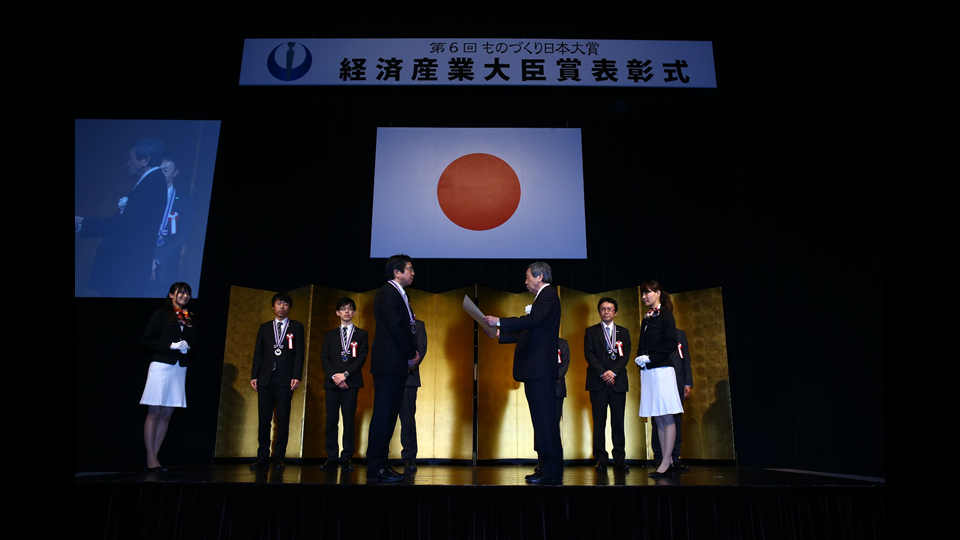
TECCELL's mass production technology and product development, which were the first in the world to be successfully mass-produced, received the "Minister of Economy, Trade and Industry Award" in the product and technology development category at the 6th Manufacturing Japan Grand Awards in 2015. TECCELL was evaluated highly for its potential use in a wide range of fields.
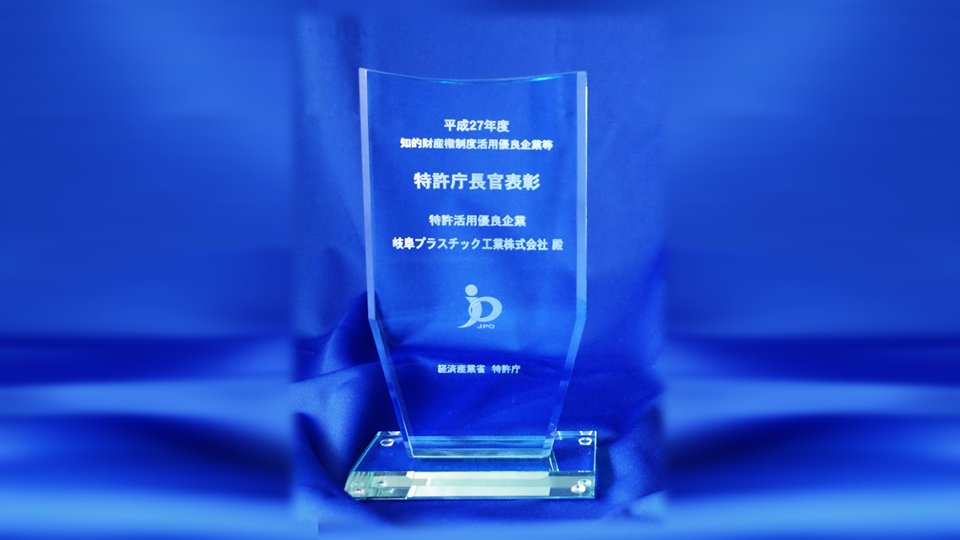
In 2015, we were recognized for contributions to the development of the intellectual property rights system and received the Patent Commissioner's Commendation at the Intellectual Property Achievement Awards hosted by the Ministry of Economy, Trade and Industry.
The proactive approach towards protecting and utilizing intellectual property was highly appreciated.
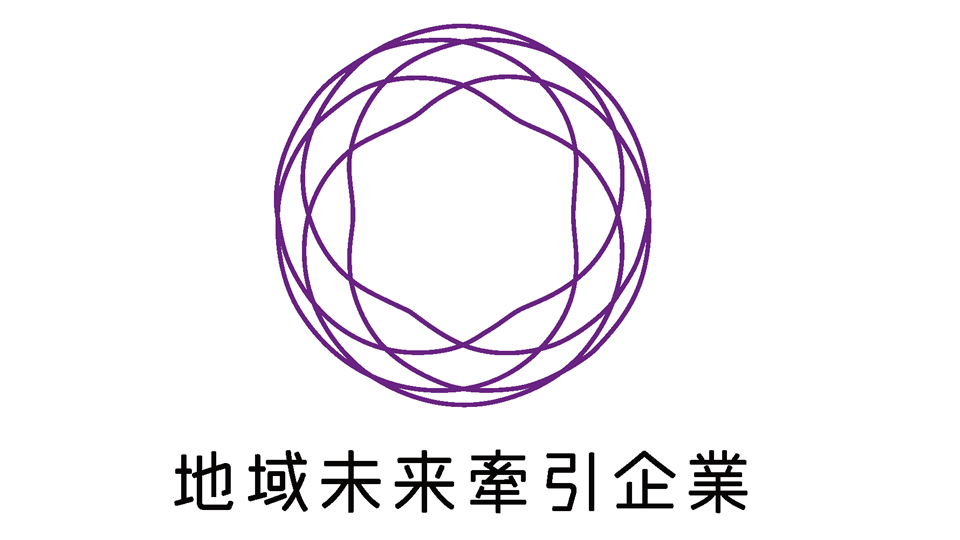
■ Regional Future-Leading Companies ■
In 2018, Gifu Plastic Industry and RISUPACK were selected by the Ministry of Economy, Trade and Industry as " Regional Future-Leading Companies" with the expectation of driving the local economy.
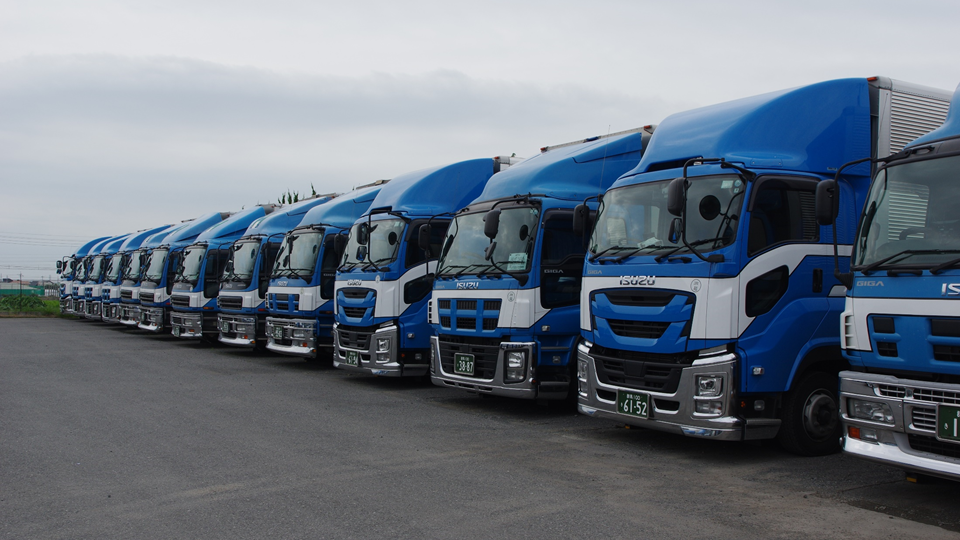
■ HASHIZUME TRANSPORTATION Co., Ltd. ■
In 2019, in response to the challenging logistics crisis, we acquired Hashizume Transportation, a transport company operating in the Kanto region, in order to leverage its extensive delivery expertise and achieve precise and efficient distribution.
Year of 2013 - Present
Increasing the handling of bio-plastic products
Gifu Plastic Group continues to pioneer the industry by aiming to reduce C02 emissions through the use of biomass plastics.
Starting with food packaging containers, we have expanded the utilization of bio-plastic products in the daily goods sector with pails, in the sports equipment sector with pool materials, and even in the logistics sector with pallets, containers, and carriers.
In this day and age, when there are growing expectations for the use of renewable energy sources other than petroleum resources, we see the practical application of plant-derived plastic products as an urgent need, and as a leader in the industry, we have been conducting research and technological development since the latter half of 1990. In recent years, the company has worked with government agencies, material manufacturers, and equipment manufacturers to commercialize and promote its products. The commercialization of these products ahead of other companies is the result of our efforts, and we will continue to focus our efforts on bio-oriented products in other fields.
Year of 2013 - Present
The soundproof panel “TECCELL-SAINT”
We discovered that by creating small holes on the surface of TECCELL, our honeycomb core material, it exhibits excellent sound-absorbing properties. In 2017, we launched the soundproof panel "TECCELL-SAINT." Since its release, we have received numerous inquiries from companies looking to improve the working environment in noisy factories and those facing noise complaints from nearby residents. Over the course of four years, we have successfully resolved over 600 cases of noise problems, contributing to the improvement of communities.
Furthermore, TECCELL's lightweight and strong characteristics have led to its adoption in the joint development of jet engine sound-absorbing panels with the Japan Aerospace Exploration Agency (JAXA) and IHI Corporation. As the concept of promoting employee health becomes more widespread, addressing noise issues in factories, which can be a significant burden for workers, is crucial for the manufacturing industry in Japan, which is grappling with labor shortages. TECCELL-SAINT, being a user-friendly product, continues to experience growing demand.
Year of 2013 - Present
Lane Markers
In 2017, we developed the "RL-150T Competition Lane Marker." This product, which was selected for installation at the Tokyo Aquatics Centre, was designed with the concept of providing athletes with the best competitive environment. Our focus was on eliminating the waves generated while swimming.
We have established a standard to quantify the effectiveness of wave dissipation by incorporating the insights of companies researching oceanography and hydraulics. Based on this standard, we developed a unique product shape with the highest level of wave-extinguishing functionality through extensive research.
Starting with its adoption at the 2017 Ehime National Sports Festival, the use of our lane markers has expanded to certified pools nationwide.
Moreover, we are pleased to announce that in 2021, our lane markers were selected as the official equipment for the swimming venue at the Tokyo Paralympics!
Year of 2013 - Present
Innovation from "Food Containers" to "Tableware"
Innovation that brings "containers" as close as possible to "tableware" based on the "on the table" concept.
We have developed a new material, White PET "PureWhite(R)," focused on achieving a smooth and glistening whiteness, similar to fine white porcelain. This innovation allows the creation of food containers that resemble tableware, allowing for a visually appealing presentation on any dining table.
The versatility of PureWhite(R) makes it suitable for a wide range of menu options, and it has gained attention in the supermarket industry for its glossy finish and brightness. Many stores have adopted PureWhite(R) due to its highly acclaimed features.
Year of 2013 - Present
Biomass Plastic Container
Since the introduction of the PLA material "BioNeut," we have developed biomass plastic containers suitable for various applications.
These include the heat-resistant natural material "PLA-H," partially plant-derived material "BioDelica," highly transparent "BioCups" widely used for fresh produce and salads, heat-resistant and transparent PLA hybrid containers "EcoA," and glossy "BioHIPS" extensively used for sushi and sashimi (as of 2020).
By 2023, the sales ratio of biomass plastic containers has exceeded 47%, marking significant growth.
As the leading company in biomass plastic containers, we aim to continue to expand our presence and contribute to the realization of a recycling-based society.
Year of 2013 - Present
Long-Lasting Design
"Trunk Cargo" is a durable storage box that has transcended the changing values and trends of the last 20 years and has cemented itself as the standard for products.
"Trunk Cargo," which has been on the market since 1998, is a storage box featuring a large buckle for easy carrying and a sturdy load capacity of 100 kg (220 lbs).
After twenty years, the "Trunk Cargo" continues to be produced and sold as a multipurpose storage box suitable for various applications such as outdoor activities, DIY projects, garage organization, and interior storage.
Its rugged yet simple and user-friendly design has stood the test of time, making it a timeless and widely accepted choice that can be used for a long time without being influenced by passing fads.
Year of 2013 - Present
Double Pipe Joint
In 2011, the Water Pollution Prevention Act was revised, requiring materials and structures that can prevent water containing hazardous substances from seeping underground and leaking out of the facility.
To meet this requirement, it became necessary to have double-layered pipes in the piping system. The prevailing method at the time involved cutting and bonding two separate pipe joints, which was time-consuming and costly.
To address these issues, TOEI KANKI developed a double-layered pipe joint that can be seamlessly molded without the need for separate processing. This innovative product offers several advantages over traditional methods. It is more cost-effective, shortens delivery times, enhances safety, and simplifies installation, contributing to shorter construction periods.
The transparent variant of the joint allows for visual inspection of liquid leakage, aiding in facility inspections and enabling prompt action when needed. This product has garnered attention for its practicality and ability to ensure early detection and response to potential issues.
- HOME
- Group Information
- History of RISU Plastic Group

